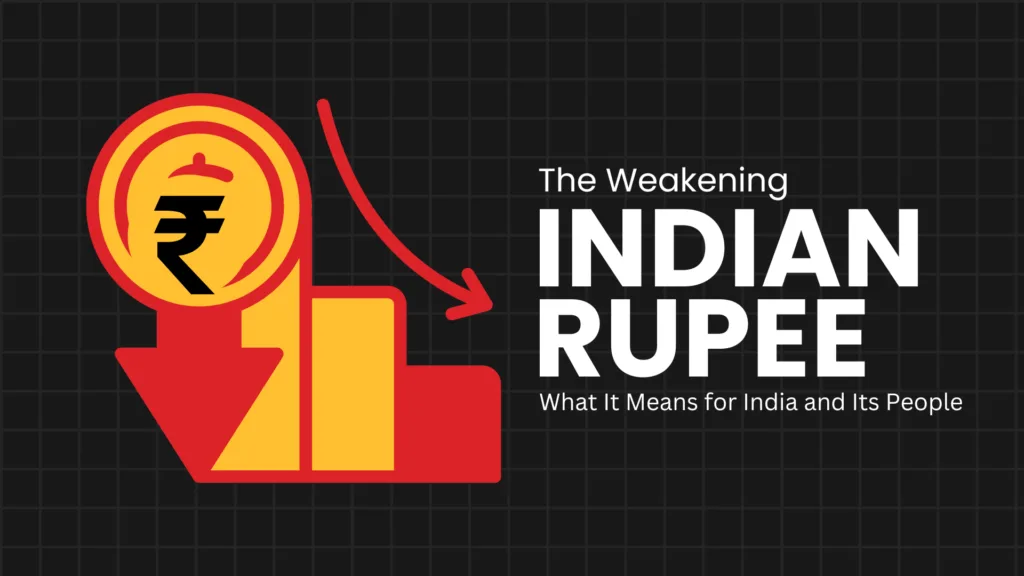
The depreciation of the Indian rupee against the US dollar has become a recurring concern for policymakers, businesses, and investors. In recent years, the rupee has faced significant downward pressure. This has sparked debates on its causes. It has also led to discussions about its far-reaching effects on the Indian economy. In this blog, we’ll explore the reasons behind the falling rupee. We will look at its impact on various sectors. We will also examine what it means for the Indian stock market and the broader economy.
Understanding Currency Depreciation
Currency depreciation means a decline in the value of one country’s currency relative to another. In this case, it is the Indian rupee against the US dollar. Some level of fluctuation is natural in a globalized economy. However, persistent depreciation often signals deeper economic issues or external shocks.
Recent Trends
The Indian rupee has seen a steady decline over the past few years. As of early 2025, it hovers at historic lows, driven by both global and domestic factors. This has raised questions about the stability of the Indian economy and its resilience in the face of external challenges. Experts point to structural deficiencies and global pressures as the main contributors to this ongoing trend.
Reasons for the Falling Rupee
1. Global Factors
- Strength of the US Dollar: The US Federal Reserve has aggressively raised interest rates. This has made the dollar stronger and attracted global investors to US assets. A strong dollar typically results in weaker currencies for emerging markets like India. Additionally, the dollar’s dominance in global trade ensures its consistent demand, exacerbating pressures on other currencies.
- Geopolitical Uncertainty: Events like the Russia-Ukraine war and tensions in the Middle East have created volatility in global financial markets. Investors often seek safe-haven assets like the US dollar during such times, further strengthening it. This geopolitical turbulence has had a cascading effect on trade, supply chains, and currency valuations globally.
- Rising Crude Oil Prices: India is heavily reliant on crude oil imports. When oil prices rise, the country’s import bill increases, widening the trade deficit and putting downward pressure on the rupee. Over 80% of India’s crude oil requirements are imported, making the economy highly vulnerable to global price fluctuations.
- Global Inflation: High global inflation has reduced the purchasing power of many currencies, including the rupee. As inflation erodes currency values, central banks worldwide adopt tighter monetary policies, indirectly impacting emerging markets.
2. Domestic Factors
- Widening Trade Deficit: India imports more goods and services than it exports, leading to a trade deficit. The gap between imports and exports increases demand for foreign currency, weakening the rupee. Persistent trade imbalances have made India susceptible to external economic shocks.
- High Current Account Deficit (CAD): India’s CAD has been on the rise due to increased imports and declining remittances, which negatively impacts the rupee. This deficit reflects an economy’s reliance on external borrowing and highlights underlying vulnerabilities.
- Reduced Foreign Direct Investment (FDI): Uncertainty in global and domestic markets has led to a slowdown in FDI inflows, depriving India of a stable source of foreign currency. Lower FDI indicates reduced investor confidence, further pressuring the currency.
- Foreign Portfolio Outflows: Foreign Institutional Investors (FIIs) have been pulling out funds from Indian equities and debt markets, further straining the rupee. These outflows are often driven by global risk aversion and tighter monetary policies in advanced economies.
- Rising Inflation: High domestic inflation erodes the purchasing power of the rupee, making it weaker relative to stronger currencies like the dollar. Inflationary pressures also lead to higher costs for households and businesses, compounding economic challenges.
Impact of the Falling Rupee on the Indian Economy
The depreciation of the rupee has both immediate and long-term implications for the Indian economy, affecting various sectors and stakeholders differently.
1. Import-Dependent Industries
India’s reliance on imports, especially for crude oil, electronic goods, and machinery, makes the economy highly sensitive to currency depreciation. A weaker rupee increases the cost of imports, leading to higher production costs and inflation. This impacts industries reliant on global supply chains, such as automotive and electronics manufacturing.
2. Export-Driven Industries
On the flip side, export-oriented industries like IT and pharmaceuticals benefit from a weaker rupee as their earnings in dollars translate to higher revenues in rupee terms. Companies like TCS, Infosys, and Sun Pharma have historically gained during periods of rupee depreciation. Additionally, sectors such as textiles and gems and jewelry also stand to benefit.
3. Inflationary Pressures
Imported goods, from crude oil to essential commodities, become costlier when the rupee weakens. This leads to higher inflation, which affects household budgets and reduces consumer spending. Inflation-driven price hikes in essentials like fuel and food further strain the average consumer.
4. Foreign Debt Repayment
Indian companies and the government often raise funds through foreign loans. A depreciating rupee increases the cost of repaying these loans, straining corporate and government finances. This also impacts fiscal budgets, diverting funds from developmental projects.
5. Tourism and Education
A weaker rupee makes overseas travel and education more expensive for Indians. This impacts families planning foreign trips or students pursuing education abroad. As tuition fees and travel costs rise, aspirations for studying abroad become financially challenging for many.
6. Investments and Savings
The falling rupee erodes the value of savings and investments held in rupees. It also creates uncertainty in financial markets, deterring both domestic and foreign investors. Long-term savings instruments like retirement funds are particularly affected, leading to a reassessment of financial goals.
Effects on the Indian Stock Market
The stock market is closely linked to currency movements, and the rupee’s depreciation has both direct and indirect effects:
1. Foreign Institutional Investor (FII) Outflows
A weak rupee makes Indian assets less attractive to foreign investors, prompting them to withdraw funds. This creates selling pressure in the stock market, leading to volatility. Such outflows also signal lower confidence in India’s economic stability.
2. Sectoral Impact
- Positively Affected Sectors: Export-driven sectors like IT and pharmaceuticals tend to perform well. These companies benefit from increased revenue in rupee terms.
- Negatively Affected Sectors: Industries reliant on imports, such as airlines and auto, face margin pressures due to higher input costs. This results in subdued performance and cautious investor sentiment.
3. Market Volatility
Currency depreciation often leads to increased volatility in the stock market, making it challenging for investors to navigate. High-frequency traders and institutional investors may find opportunities in this volatility, but retail investors often bear the brunt.
4. Hedge Costs
Companies engaged in international trade often hedge their currency risks. A weaker rupee increases hedging costs, impacting profitability. Sectors with significant global exposure may find their margins under pressure due to these rising costs.
What Can Be Done to Stabilize the Rupee?
The Reserve Bank of India (RBI) and the government have a crucial role in managing currency fluctuations:
1. RBI Interventions
The RBI often sells foreign exchange reserves to stabilize the rupee. It also tweaks monetary policies to curb volatility. While such interventions provide temporary relief, they are not sustainable solutions.
2. Reducing Import Dependence
Encouraging domestic production and reducing reliance on imports can help stabilize the trade deficit and support the rupee. Initiatives like “Make in India” aim to address this structural challenge.
3. Promoting Exports
Providing incentives to exporters can boost foreign currency inflows, strengthening the rupee. Enhanced competitiveness in global markets can also make Indian goods more attractive.
4. Attracting Investments
Policies that attract FDI and retain FII investments can improve dollar inflows, easing pressure on the rupee. Stable and transparent policies are key to fostering investor confidence.
5. Energy Transition
Investing in renewable energy can reduce dependency on crude oil imports, thereby improving the current account balance. A shift towards sustainable energy sources also aligns with global environmental goals.
How Should Investors Respond?
Investors can adopt several strategies to navigate the challenges posed by a depreciating rupee:
1. Diversify Investments
Holding a mix of domestic and international assets can hedge against currency risks. Diversification reduces overall portfolio risk and provides exposure to growth opportunities globally.
2. Focus on Export-Oriented Sectors
Investing in sectors like IT and pharmaceuticals can provide stability during currency depreciation. These sectors are well-positioned to benefit from global demand and currency advantages.
3. Gold as a Hedge
Gold is considered a safe-haven asset and often performs well during periods of currency volatility. Including gold in your portfolio can act as a buffer against uncertainties.
4. Monitor Global Trends
Keeping an eye on global economic developments can help investors make informed decisions. Awareness of macroeconomic trends allows for proactive adjustments to investment strategies.
Conclusion
The depreciation of the Indian rupee against the US dollar is a complex issue influenced by global and domestic factors. While it poses challenges like higher inflation and increased costs for imports, it also offers opportunities for export-driven sectors. By understanding the reasons behind the rupee’s fall and its impact, stakeholders can make informed decisions to mitigate risks and leverage potential benefits. For policymakers, the focus should be on structural reforms to reduce import dependence and promote a robust, resilient economy. For investors, a balanced and diversified approach can help navigate the uncertainties of a depreciating currency.




